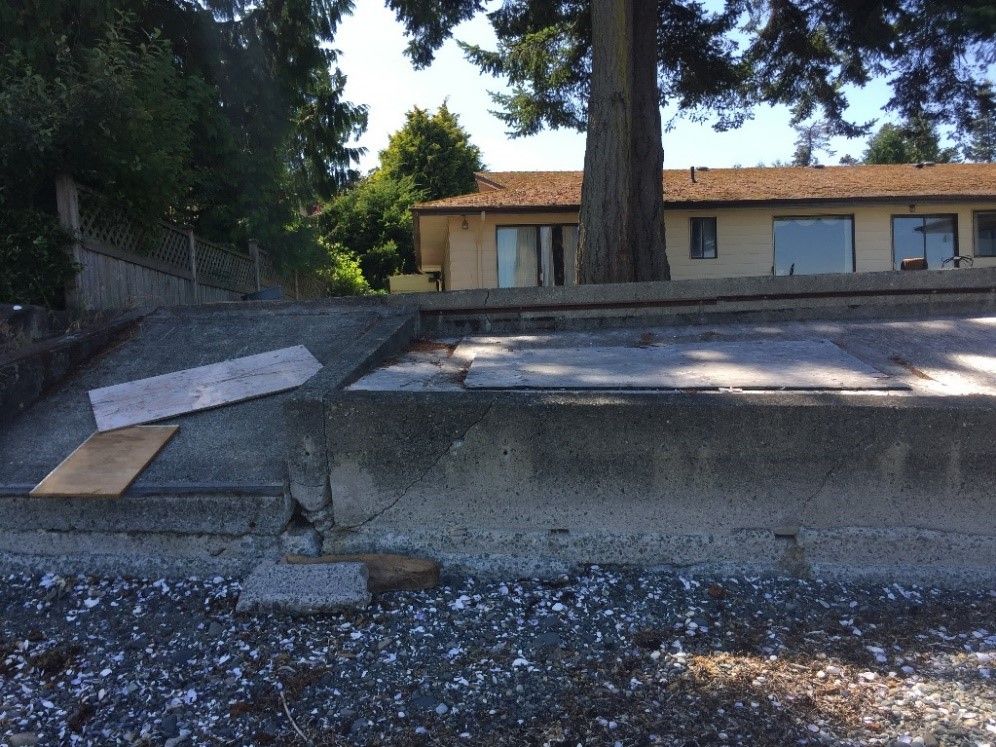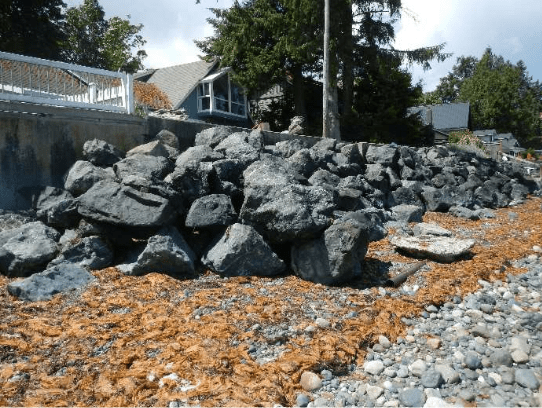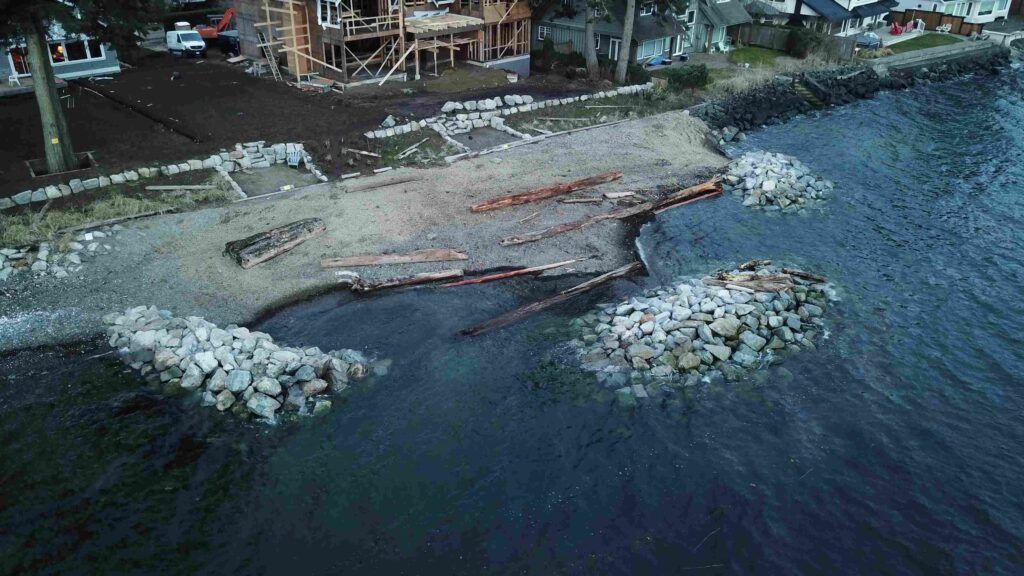Homeowners Craig Hodge and Darla Furlani wanted to protect their double-lot residential shoreline on Higson Crescent in Qualicum Beach. With the help of a team of qualified shoreline professionals, they embarked upon an innovative project using Green Shores softshore and hybrid techniques.
The Green Shores hybrid design was developed by Northwest Hydraulic Consultants to be resilient to rising sea levels and increasingly powerful storms. It incorporates strategically placed rocky headlands that buffer wave energy and protect the shoreline. The original seawall was buried and overplanted with native vegetation, and the beach level was raised by two metres through the addition of nourishment, including gravel and sand. The beach is well-anchored by native vegetation and woody debris and has remained stable throughout numerous storms. The property now provides habitat for shorebirds, Pacific herring, and other wildlife. The headlands have also become home to various aquatic species.
Completed in 2022, this project maximized all available credits within the Green Shores for Homes Credits and Ratings Guide and received a Green Shores Gold Rating. The homeowners regularly monitor the conditions of their shoreline and are prepared to make incremental adjustments as necessary.
For more information about hybrid designs for higher-energy shoreline sites, please see credit 1.5 within the Green Shores for Homes Credits and Ratings Guide.
Higson Crescent History
From the 1920s to the 1960s, these Higson Crescent residential lots were part of a larger land parcel featuring a popular summer resort with a beautiful sandy beach. However, in or around the 1970s, the land was subdivided, homes were built, and low walls were installed to edge grass lawns and prevent them from being infiltrated by beach vegetation and sand.
Naturally sloping shorelines and intertidal vegetation absorb wave energy and facilitate the healthy movement of sediment, water, and nutrients. The introduction of seawalls disrupted this process. Instead of dissipating energy as they reached the beach, waves began crashing against the walls at high tide, redirecting energy back into the water. This led to the scouring of sandy beach sediments in front of the wall and adjacent properties, causing erosion and a drop of approximately 3 metres in beach height over 50 years. As the walls were undermined, they were replaced with larger ones, further deteriorating natural shoreline processes. This scouring destroyed critical habitat and negatively impacted the safety, accessibility, and recreational value of the site
What did you hope to achieve with this project?
When we started building our home on Higson Crescent, we had a serious problem to solve. When we bought the property, the concrete seawall was starting to fail. The previous owner stacked rocks in front of the wall to prop it up, but it was dangerously undermined by erosion. I knew I had to do something, but, at the time, I didn’t realize there were alternatives to hard armouring.
How did you learn about Green Shores Nature-Based Solutions?
I went to the city and said, I'm planning to rebuild the home, and I'm going to need to build a new seawall. Luke Sales (Director of Planning and Community Development for Qualicum Beach) asked if I would consider another option. He told me that Green Shores nature-based approaches could both protect the property from damage and restore the look of the beach to resemble what it once was. We would essentially mimic a natural shoreline by adding natural materials, like sand and gravel, to raise the beach to previous levels, plant native vegetation to anchor the shoreline, and make sure that the flow of water, sediment and nutrients wouldn’t be impeded.
Why Did You Choose Green Shores for Homes Nature-Based Approach for Your Shoreline?
We had several reasons. My wife and I are both environmentally conscious and try to make decisions that align with our principles, such as reducing waste and conserving nature. We have three kids, and we do worry about the future. Restoring the beach with nature-based approaches allowed us to minimize unwanted impacts while also protecting our property from the effects of climate change, like erosion and flooding from rising sea levels and storms.
Before the project, we had to put up storm boards every winter to protect against waves overtopping the wall. The water went higher, and the beach continued to drop. Green Shores recommended solutions that helped us address those concerns and some of our other considerations.
For example, we researched the history of these properties and discovered this was once the site of an elegant tourist lodge. In pictures from the 1920s to the 1940s, we can see a beautiful walkout sandy beach. In later years, the beach was destroyed, beginning with the construction of a one-foot wall, then a three-foot wall, and most recently, a six-foot sea wall with rocks piled in front to prop it up.
The Green Shores design provided a way for us to correct the damage, raising the beach so it more closely resembles the natural walkout beach that used to exist. Our house is designed to allow us to age in place, and this aspect of the design will allow us to enjoy our beach for many years to come as well.
Did you experience unexpected challenges?
There was some controversy around our decision to apply nature-based solutions on our shoreline. A few neighbours still believe this Green Shores approach was the wrong way. They think the best way to fight climate change is more engineering - build bigger, build stronger – and seem to suspect that their own erosion has something to do with our project. However, looking at pictures from before the 1970s, there was no sea wall, or at most, a one-foot step-down wall. Between 1970 and 2020, walls were built, rebuilt, and reinforced. We didn't realize back then that we were actually contributing to the erosion problem with these walls.
Permitting was also a challenge. Things are easier now because there is an expedited permitting process, and people are more familiar with Green Shores projects. However, navigating the various permits and licenses required by different levels of government back then was difficult. For example, the application for a License of Occupancy, which is required to do work on the foreshore, provided several boxes to tick, none of which applied to this project. We weren’t building a wharf, a fish farm, or filming movies. There was no box to tick for environmental remediation or doing a Green Shores project. Our project team and the government staff worked together and figured it out, but it did make the process quite complicated.
What Benefits Have You Experienced?
For us, the project accomplished two very important things: it protected the property and the investment we made and had a positive ecological impact. So, it was a win-win. However, we have noticed other benefits as well.
Benefits to Neighbours - The project has positively impacted our eastward neighbours due to restoring natural sediment movement. The neighbours immediately to the east saw their beach return almost as it had in 1970 without doing any restoration work. They have a one-foot wall where they can step down directly onto the beach. They benefited because the currents, which carry sediment, work in their favour. So, this Green Shores project not only benefited me, but it benefited my neighbour as well.
Benefits to Wildlife – Sandbars are forming in front of the headlands. The sandbars contribute to making intertidal pools, which are prime habitat for a lot of aquatic species. Seaweed washes up on the beach, which provides habitat and nourishment. Previously, that couldn’t happen because it would hit the wall and wash right back down. And during the spring spawning season, we’ve even seen Pacific herring roe in the intertidal zone. Herring and herring roe are important food sources for shore birds and Pacific salmon, which, in turn, feed orca whales and other creatures supporting the whole aquatic food web.
During the first year, we were surprised to see beach vegetation springing up almost overnight. Our other native plantings, like dune grass and Nootka rose, provide habitat for still more birds and other wildlife.
Benefits to the Community - Before completing this project, it wasn’t possible to walk in front of our property during high tide because the water came right up to the base of the wall. Now, you can walk across the beach even at high tide. People walk there every day and sometimes sit on the rocks we placed there, posing for pictures and watching the sunset. When we first proposed the project, we went through a public hearing process. Some people complained that this would cause a loss of access to the beach. In fact, the opposite happened. We actually increased access, and now lots of people enjoy walking along the beach without worry of being caught out by the high tide.
While this project protects our shoreline, it also protects our neighbours and the town. Before completing this project, there were a couple of times when powerful waves overtopped the seawall, flooding our backyard and our neighbour's yard and washing all the way to the street. The town had to come onto our property and place sandbags because the floodwater jeopardized city infrastructure. When residents take it upon themselves to do environmental remediation and protect their portion of the shoreline, it benefits everybody.
Potential Benefits from Neighbourhood-Scale Shoreline Rehabilitation - Rehabilitating a single property can provide many benefits. Still, the possibility of addressing a continuous stretch of shoreline as a community would be an even stronger application of Green Shores. Working together can save time and money. For example, our coastal engineers' work in charting tides, wind, and wave energy and predicting sea level rise is probably relevant beyond just my property.
I hope my neighbours on the west decide to adopt these approaches because I believe that we, and anyone downstream, will benefit from addressing the entire stretch of shoreline as a neighbourhood. As I mentioned, our eastward neighbour now has a full beach thanks to the natural processes restored through our project. And native vegetation has naturally extended from our property to hers.
Raising Awareness and Encouraging Acceptance - I’ve spoken with neighbouring homeowners since the project was completed. One has a deteriorating seawall, so they are exploring options. Another lost their seawall during an intense storm two years ago, whereas our property was fine. Their curiosity was piqued, so they want to see what we’ve done here. I’ve told them all about the success of our project and how pleased we are with the protection it offers, the look of it, and regaining easy access to the beach.
People from outside of the neighbourhood are also interested in seeing the beach. Large groups have come here to see how we applied nature-based and hybrid solutions, like the headlands, and how they perform as the project matures. This could be important in raising awareness and changing attitudes about shoreline protection. People want evidence that nature-based alternatives to traditional hard armouring are effective, and seeing these approaches in action can show that some of their anxieties, such as cutting off access to the beach, are unfounded. But it might ultimately be a generational change – it’s hard for some people to get used to a more natural aesthetic and trust natural processes.
Before Green Shores

Eroded shoreline and concrete seawall before Green Shores. Photo: Kelly Loch

Concrete seawall and riprap revetment before Green Shores. Photo: Northwest Hydraulic Consultants Ltd.
Project in progress

Aerial view of Higson Crescent Green Shores Hybrid Design
After Green Shores
Higson Crescent

After Green Shores – The seawall was buried, and the beach was raised by 2 metres using various types of nourishment, rock, gravel, and sand.
Sources:
Interview with the Homeowner, Craig Hodge Aquaparian Environmental Consulting Environmental Assessment for Higson Crescent, Feb 5, 2020,